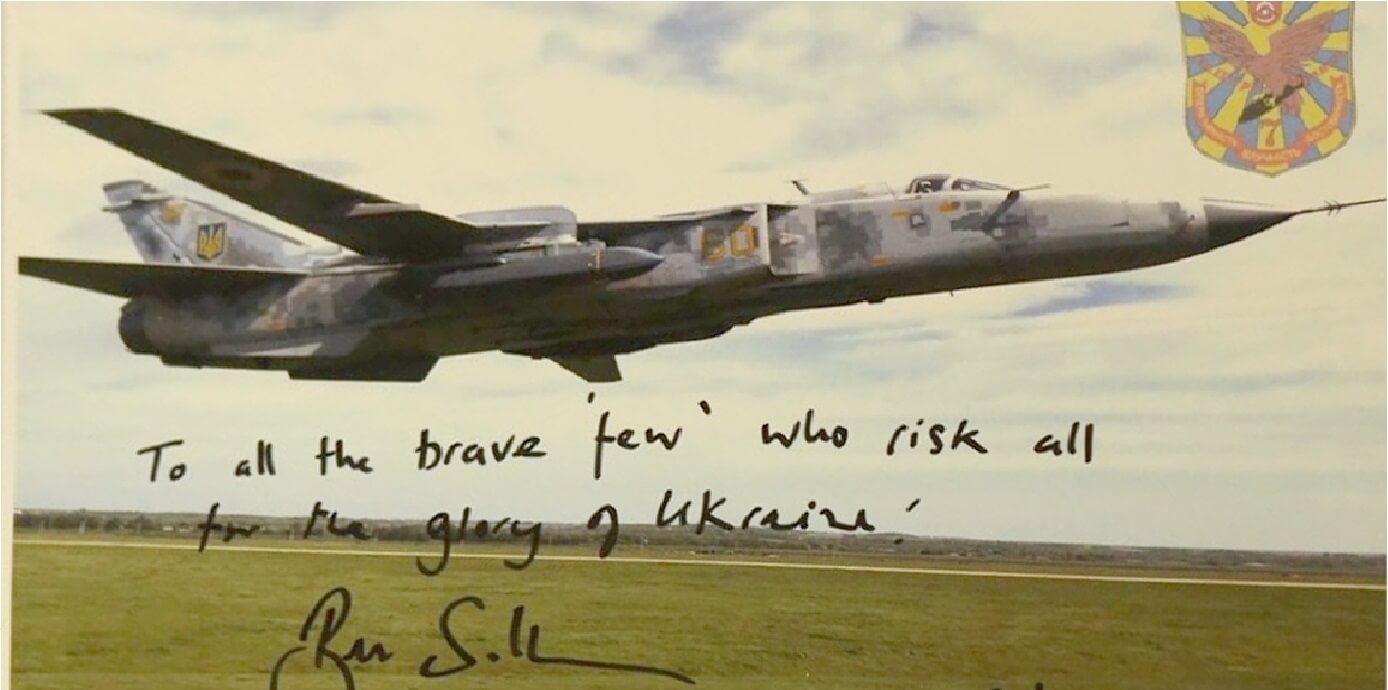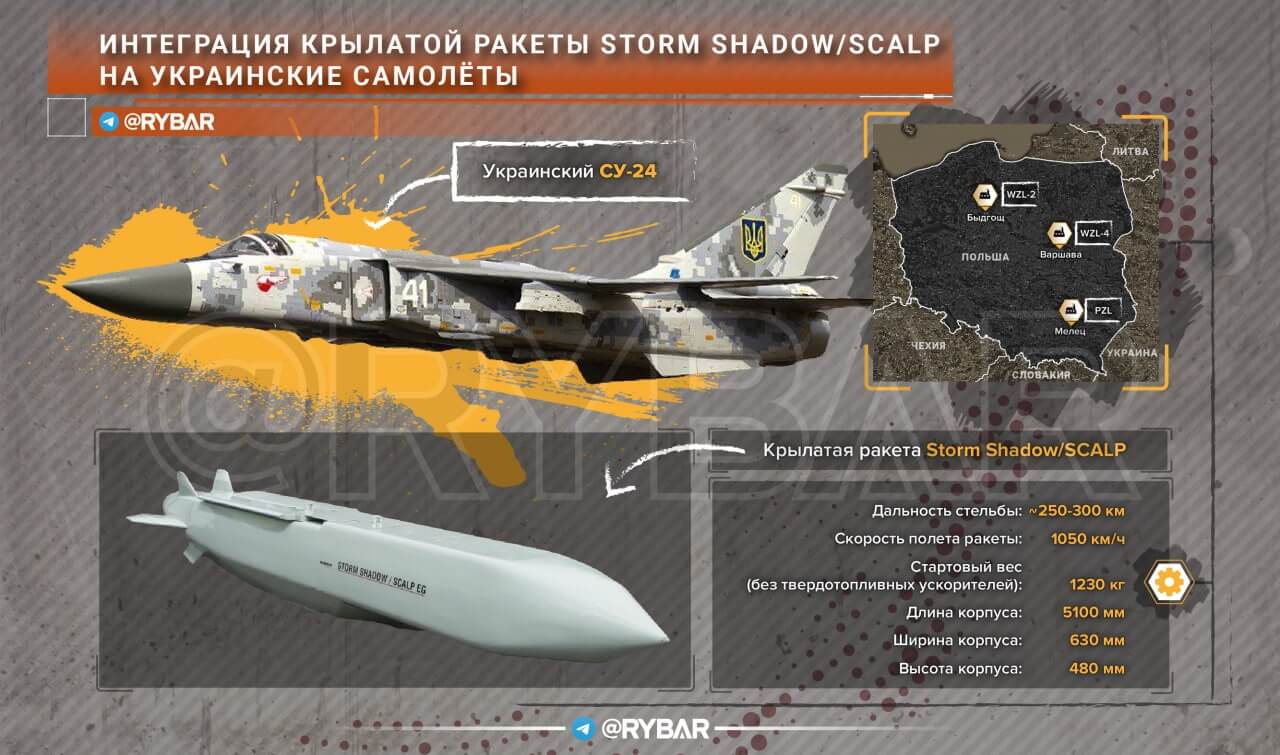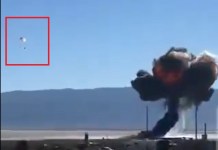The recent image of a Ukrainian Air Force (UAF) Sukhoi Su-24 Fencer carrying the British Storm Shadow has revealed another elaborate effort to fuse Western and Russian origin systems.
Ukrainian Defense Minister Olexii Reznikov released the picture in the first direct admission that the Soviet-era jet was being used to fire the newly acquired long-range missile.
The image showed a Storm Shadow being carried beneath the swing-wing ‘glove’ pylon on the right side of the jet. UK Defense Secretary Ben Wallace autographed the photo with: “To all the brave ‘few’ who risk all for the glory of Ukraine.”
Another Hack To Fuse East & West
How Ukraine might modify the Su-24 to fire the Storm Shadow can be guessed by two other famous projects fusing Russian and Western systems. First is the episode with the Indian Air Force, which fused the Russian R-73 with the French Mirage-2000 with Israeli expertise.
The other is integrating Ukrainian MiG-29 fighters with the American AGM-88 High-Speed Anti-Radiation Missile (HARM), which initially saw minimal success against Russian ground-based radars.
The missiles later were found to miss their targets as Russian radar crews developed tactics against it, as was concluded in previous analyses in the EurAsian Times.

Russian R-73, French Mirage-2000 ‘Married’ By Israel
To replace the aging R-530D Magic missiles on the Mirage-2000 in 2008, the Indian Air Force (IAF) had to go against French and Russian objections to integrating the R-73 onto the delta-wing fighter.
In the book ‘Indian Air Force: The Case for Indigenization,’ former Deputy Chief of Air Staff Air Marshal AK Nagalia recalled how Israeli engineers were allowed access to the Mirage-2000’s Digibus. This chipset trades information between the jet’s various sub-systems and mission computers.
Israeli companies Elbit and Rafael, manufacturers of the DASH helmet-mounted display and Crystal Maze air-to-surface missile (ASM), undertook the project.
An HMD projects flight display, readings, and other information directly on the pilot’s visor. This reduces the stress of flying and focuses more on the combat part.
Lacking the software ‘source codes’ of the Mirage’s radar, the Digibus allowed the Israeli engineers to decode the data bus protocol through “extensive trials.” New algorithms allowed the Mirage’s radar and the Israeli HMD to ‘talk’ to the Russian missile.
US AGM-88 HARM & Ukrainian MiG-29
In September last year, photos and videos of an AGM-88 missile mounted on one of the Ukrainian Soviet-made fighters showed a pylon adapter attached to the fighter’s pylon.
‘Ukraine Weapons Tracker,’ an Open Source Intelligence (OSINT) Twitter handle that tracks the war in Ukraine, had said the Ukrainian Air Force is employing the AGM-88 missiles using the standard LAU-118/A launcher that is mounted on a newly fabricated pylon-adapter, intended especially for AGM-88.
The LAU-118/A missile launcher provides the mechanical and electrical interface between the AGM-88 missile and the launch aircraft, usually the American F-16s or F/A-18s. Through this interface, the HARM can communicate with the aircraft’s radar warning receiver (RWR) and the launch computer of the aircraft.
But how it fires the HARM and how exactly the launcher possibly integrates with the MiG-29’s systems was analyzed by the Israeli newspaper Calcalist. The article said the launcher is not powered by the plane but by an external battery attached to the aircraft.
Instead of connecting the launcher with the MiG-29’s computer, a cable stretching from the launcher to the cockpit is connected to a radar sensor and a launch button. The sensor works 24/7 because it also receives power from an external battery, eliminating the need to fuse with the older Soviet-era electronics of the MiG-29.
Storm Shadow Pre-Programmed Before Launch
In the case of the Storm Shadow, the picture did not show any launcher adapter on the sign pylon of the Su-24 Fencer. Thus, what kind of modifications have been made to the fighter to fire the missile remains unclear.
The only possibility could be the missile being pre-programmed with the location and target coordinates before the flight. The pilot, therefore, does not have to feed in fresh targetting data during the flight.
An analysis by John Siddharth, head of research and consulting at Aviation and Defense Market Reports, broadly matches this conclusion. Speaking to EurAsian Times, Siddharth lists three steps that would need to be addressed while integrating Western and Soviet weapons like the Storm Shadow and the Su-24.
“There is the physical integration to have lugs to carry and release the weapon, study the computational fluid dynamics (CFD) analysis, and weight and balance compatibility.”
This is followed by electrical work of the connector being made “compatible for power, firing command and any transfer alignment data that needs to be done prior to launch.”
“Last stage is the datalink compatibility which is the most difficult. This is for any updates that may be needed post-launch to provide a low Circular Error of Probability (CEP). This may not have been done, or it may be fired on fire and forget mode with no target update after launch,” Siddharth explained.

Ukraine Needs More to Make an Impact
Despite being highly advanced and lethal, the missile is still not the wonder weapon to turn around the battlefield. By mid-May, Russia’s Ministry of Defense (MoD) claimed to have shot down seven Storm Shadows.
Secondly, it would require a massive number of such missiles, at least 500 and an equal number of available aircraft, to make any credible difference on the battlefield.
Co-developed by Matra and British Aerospace, and manufactured by MBDA, the Storm Shadow (French variant SCALP-EG) is a turbojet-powered missile that cruises at Mach 0.8 to a max range of 560 kilometers.
It’s a relatively small missile, weighing just 1.3 tons, and packs a 450-kilogram warhead. The Storm Shadow has a length of 5.1 meters, a maximum body diameter of 48 centimeters, and a wingspan of 3 meters.
- The author can be reached at satamp@gmail.com
- Follow EurAsian Times on Google News




